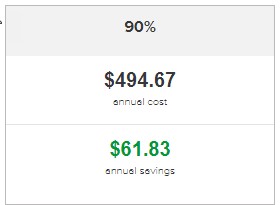You like the idea of reducing your home heating bills, but you've probably noticed a significant price difference between the medium- and high-efficiency furnaces. Are you wondering whether a high-efficiency furnace is worth the extra cost?
Let's explore whether a high-efficiency gas furnace makes sense for your home.
Furnace Efficiency (AFUE)
The efficiency of a furnace is measured by its
Annual Fuel Utilization Efficiency (AFUE) rating. The higher the AFUE rating, the more efficient the furnace is. A furnace with an AFUE rating of 95% will require significantly
less fuel (natural gas) to heat your home than a unit with an 80% AFUE rating. While higher-efficiency furnaces tend to cost more upfront, they allow homeowners to save money on heating costs every year.
If you live in a climate like Minneapolis – where the average low temperature is 7 degrees Fahrenheit during January – you are more likely to save money with a high-efficiency furnace than someone whose winters are warmer. AFUE ratings should always be an important factor when buying a furnace in Minnesota.
Below, you can see the estimated annual fuel savings (in dollars) for a Minnesota homeowner replacing an old, 80% efficiency furnace*. Or, you can try plugging your own, unique data into CenterPoint Energy's
Furnace Efficiency Calculator to see the potential money-saving results.

As you can see, a customer could save $87.87 [UPDATE if 96% calculations are available] each year in natural gas by replacing an 80% furnace with a 95% model. Assuming your furnace is replaced after 15 years of use (what we recommend) you would get a total fuel savings of $1,318.05. A 90% furnace would save you $927.45 in fuel, compared to an 80% furnace.
You can see how a high-efficiency furnace may end up being worth the extra money it costs you at the time of purchase. Once you reach the payback period, the time it takes to recover the cost of an investment, the high-efficiency furnace has paid for itself and begins
saving you money, overall.
Let's take a look at how furnace technology affects efficiency, comfort and pricing.
Single-Stage, Two-Stage & Variable-Speed Furnaces
When you're furnace shopping, you'll probably notice that each model is a single-stage, two-stage or variable-speed (modulating) furnace. While the AFUE rating tells you how efficient a furnace is, it is also helpful to understand how furnace technology impacts sticker price, operating cost (efficiency) and comfort.
A
single-stage furnace is the simplest furnace, as it only has one flame setting. It's either on or off; there's no 'low' or 'medium' setting. This simple furnace costs less than complex models, but it has a few big downsides. Single-stage furnaces allow wide fluctuations in your home's temperature and they're less efficient, costing you more money to operate.
For example, if your thermostat is set to 68 degrees for a single-stage furnace, your home's air temperature may drop as low as 64 before the furnace kicks on. When it does, the single-stage furnace might heat the air as high as 72 degrees before turning off. That's a big temperature swing!
A
two-stage furnace has two heat settings, 'low' and 'high,' giving it greater efficiency than a single-stage model. It also provides better comfort. A two-stage furnace (or
dual-stagefurnace) will have a higher price tag than a comparably sized, single-stage furnace.
If your thermostat is set to 68 degrees, a dual-stage furnace will probably allow it to drop as low as 66 before it kicks on. It will heat your air a bit higher than your set point of 68, perhaps as warm as 70.
A
variable-speed furnace (or
modulating furnace) is the most efficient and most comfortable furnace. It changes its heat setting in small increments, so your home's air temperature rarely varies more than a degree or two from your thermostat settings!
Of course, the advanced technology means a modulating furnace costs more than single- or two-stage models. But remember, you may end up offsetting the price difference with better efficiency (using less fuel). If (and how soon) you begin saving money with a high-efficiency furnace may depend on your furnace usage and home size, as well as other key factors.
More Furnace-Buying Factors
Now that we understand how furnace efficiency can pay for itself over the long run – and give you extra comfort – let's look at some other considerations for determining whether a high-efficiency furnace is worth the money.
Tax credits: Buying a high efficiency furnace can give you a tax credit. Learn more via this article written by the IRS, 'Get Credit for Making Your Home Energy Efficient.'
Gas prices: Natural gas prices right now (January 2018) are relatively normal or a bit low when you look at the past 30 years. If natural gas prices increase during the lifetime of your furnace, your savings will be even greater than those we calculated earlier in this article.
Cleaner air: The higher the efficiency of your furnace, the fewer greenhouse gas emissions your home generates. Cleaner air is something we all benefit from, including future generations.
Personalized Furnace Advice
If you live in Minneapolis, St. Paul, or our greater Minnesota service area, a furnace expert from Home Service Plus (HSP) will help you understand how each
new furnace option will impact both your comfort and heating costs.
In this FREE furnace consultation, the expert will measure your home and perform a comprehensive heat loss/gain assessment. Afterward, he or she will sit down with you to review all available furnace options, rebates and special promotions.
Request your FREE furnace consultation online, or call HSP at
612-342-4610 in the Minneapolis/St. metro area; toll-free
877-HSP-1664 in greater Minnesota.
